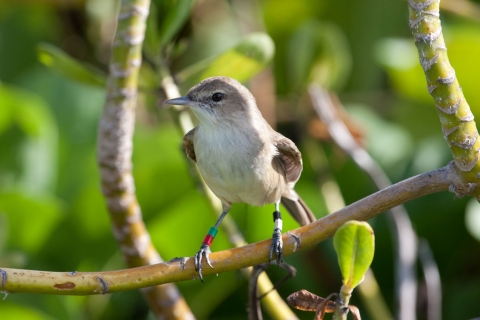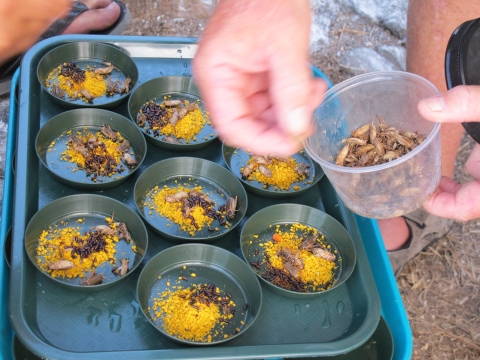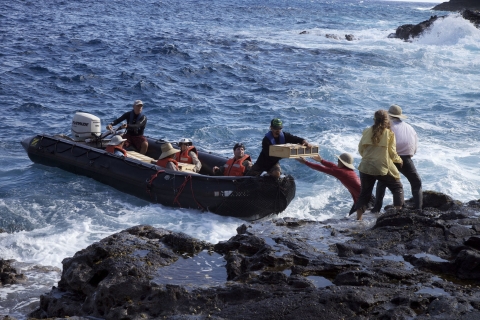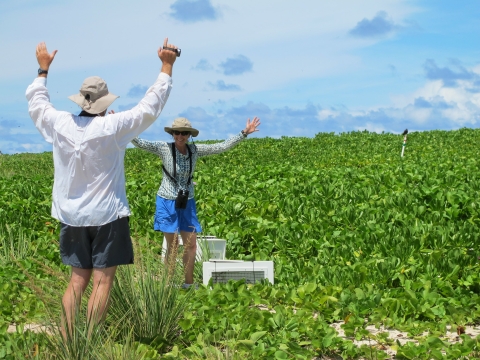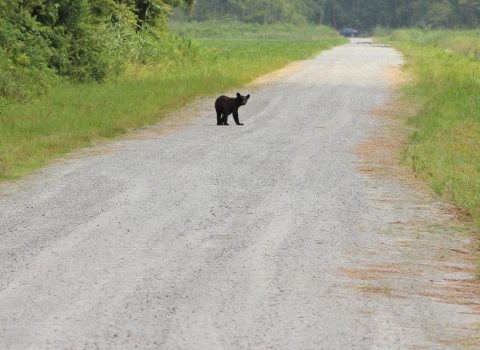EDITOR'S NOTE: 2023 marks the golden anniversary of the ESA, a law that has been a powerful catalyst for conservation of America’s most treasured fish, wildlife, plants and their habitats for five decades. People power the mission of the U.S. Fish and Wildlife Service. Here in the Pacific Region, Tribal, federal and state partners, local supporters, and our dedicated staff are the driving force behind the successes we share and the strength ensuring we can continue to face the challenges ahead. Throughout this year-long celebration, we invite you to celebrate this milestone with us as we reflect on past successes, assess current challenges, and envision an equally bright future for the next 50 years and beyond.
On tiny islands in the vast Pacific Ocean, thousands of species found nowhere else evolved over eons in isolation. In modern times, these unique plants and animals have faced an onslaught of threats such as habitat loss, foreign diseases, and imported predators. While the U.S. Fish and Wildlife Service and its partners work hard to protect these species and their habitats across the Pacific, climate change climate change
Climate change includes both global warming driven by human-induced emissions of greenhouse gases and the resulting large-scale shifts in weather patterns. Though there have been previous periods of climatic change, since the mid-20th century humans have had an unprecedented impact on Earth's climate system and caused change on a global scale.
Learn more about climate change and sea level rise pose new threats that aren’t easily managed.
Conservation efforts often focus on preserving habitat to ensure species can continue to survive in their natural environments. And while this is sufficient for many species, others are threatened by uncontrollable events such as increased storm intensity and frequency and sea level rise that put them at high risk of extinction. Sometimes these threats loom so large that wildlife managers turn to a more difficult option to safeguard the species — conservation introduction.
Conservation introduction is the intentional movement of a species from its current location to an area outside the species’ native range, in an effort to improve the overall conservation status of the species. Conservation introductions have been used several times in the Pacific Islands to reduce the risk of extinction. For example, the ulūlu, Nihoa millerbird, underwent a conservation introduction in 2011 and 2012.
Found only on the tiny, uninhabited island of Nihoa, the ulūlu was on the verge of extinction. Its population was so small, scientists were worried that a single hurricane or accidental introduction of an invasive predator could wipe the species off the map. And with intensifying hurricanes in the Pacific and an invasive grasshopper outbreak on Nihoa that decimated island vegetation and threatened ulūlu habitat, the ulūlu had a lot working against them.
Wildlife managers weighed their options, but much of what threatened the ulūlu was uncontrollable. They knew that performing a conservation introduction to create a second population was their best option to reduce the risk of extinction for the species. But they did not make this decision lightly. While the idea of a conservation introduction may sound simple, the reality of performing one is extremely complex and carries some serious risks. For example, an introduced species could outcompete other native species for food or habitat, prey on native species, or bring new diseases to the ecosystem. The team knew it would take many dedicated people and an enormous amount of science and preparation to assess the risks of the introduction, collect species background information, select a site, capture, hold, and transport the species, and conduct post-release monitoring. So, in partnership with the Papahānaumokuākea Marine National Monument, the Office of Hawaiian Affairs, and the American Bird Conservancy, the U.S. Fish and Wildlife Service got to work.
Before a conservation introduction can take place, wildlife managers must gather as much background information on the species and potential release sites as possible. For the ulūlu, the introduction team worked for more than 5 years collecting information to support important project decisions.
First, the team had to assess the food and habitat needs of the bird. This meant studying everything from the number of insects birds needed to eat in a day to the structure structure
Something temporarily or permanently constructed, built, or placed; and constructed of natural or manufactured parts including, but not limited to, a building, shed, cabin, porch, bridge, walkway, stair steps, sign, landing, platform, dock, rack, fence, telecommunication device, antennae, fish cleaning table, satellite dish/mount, or well head.
Learn more about structure and composition of their habitat. But that was not all. The team also had to collect important information on ulūlu genetics and learn how to sex the birds upon capture. The team had to ensure they could move the right ratio of males and females to give the birds the best chance at mating successfully in their new home.
Wildlife managers also must carefully determine the best introduction site for the species including conducting a careful assessment on how the introduced species may impact the new site’s native flora and fauna. For the ulūlu introduction, the team convened a group of 18 experts to evaluate a short list of potential islands before they settled on the island of Kamole (Laysan) as the introduction site.
Though invasive rabbits had decimated the vegetation on Kamole in the early 1900’s causing the extinction of the Laysan millerbird and several other native birds, after more than 20 years of restoration by the U.S. Fish and Wildlife Service and partners, the island’s ecosystem was once again healthy. Because the island had supported a different millerbird subspecies in the past, it would likely support another millerbird subspecies in the future without negative impacts to the other native species on the island.
Once a new introduction site is chosen, the planning begins. The logistics of physically moving animals from one area to another can be complicated and sometimes even dangerous. For the ulūlu introduction, the team had to plan how to transport the birds over 650 miles of open ocean, with sharp rocks and steep cliffs to navigate at Nihoa, and no docking infrastructure.
In addition to ensuring personal safety, a conservation introduction team must also consider the safety of the species being moved as there can be significant risks. Many species are very sensitive to changes in their environment and may not survive the stress of being captured and transported long distances in captivity. Planners must weigh the risk of losing individuals of a rare species against the potential gains.
One of the biggest challenges for the team was figuring out how to safely contain such energetic, insectivorous birds for a long period of time without them becoming too stressed or losing weight. To do this, biologists stayed on Nihoa for several weeks running feeding trials and developing ways to safely hold the birds before the introduction. Through creativity and determination, the team designed special bird boxes that allowed the birds to safely move around and feed during the voyage.
Once the biological and ecological needs of a species are assessed, an introduction site is chosen, consideration of possible impacts to other species at the site are assessed, and logistics are worked out, the actual movement of the species from one location to the next can finally take place.
Moving the ulūlu were no easy feat. The team had to traverse sharp cliff sides and battle the swell and surge of the sea, all while staying calm and keeping their balance to ensure the precious birds made their way safely from Nihoa to the ship that would eventually take them to Kamole. But despite all the challenges, the movement of the birds went smoothly and swiftly. In fact, in recognition of their flawless journey from Nihoa to Kamole, the introduced birds were given a new Hawaiian name to differentiate them from the Nihoa population. This new name is ulūlu niau.
Ulūlu: a reduplication of ulu — to grow, increase, spread.
Niau: to move smoothly, swiftly, silently, and peacefully.
After an introduction, the species must be monitored carefully. Managers need to know whether the population becomes established and grows, and where additional support is needed to increase the odds of success. Monitoring is extremely time and resource intensive, often taking weeks to months of costly staff time. For example, after the ulūlu niau introduction, teams of biologists stayed on the island and monitored the birds continuously for two years, and in subsequent years traveled to Kamole to spend several weeks conducting bird surveys.
Despite how challenging performing a conservation introduction might be, to see a species like the ulūlu niau flourish on Kamole makes it all worth while. These days, the ulūlu niau is thriving, with years of survey data showing that they are feeding, breeding, and growing in numbers.
Unfortunately, even when conservation introductions are done with the same care and attention to detail as the ulūlu niau effort, success is never certain. Still, for some species, a conservation introduction might be their last chance at survival. Currently, several species of Hawaiian honeycreepers are being considered for conservation introductions with several more expected to be proposed in the coming years as climate change exacerbates threats and causes species populations to decline. For many, their best chance at survival will be to move to safer, often cooler and higher altitude places in Hawaiʻi.
With more and more species edging closer to the brink of extinction due to climate change, the need for conservation introductions is expected to increase. The U.S. Fish and Wildlife Service is developing a new regional framework to help wildlife managers in the Pacific Islands and Pacific Northwest make better choices about the tool. Informed by case studies like the ulūlu niau, a new National Park Service risk evaluation document, and input from partner organizations, this framework will give biologists and managers a more robust and consistent foundation for making and prioritizing conservation introduction decisions.
Mahalo to the dedicated people who work tirelessly to protect and conserve the beloved plants and animals that make these islands home. And may the ulūlu niau continue to live up to its name and thrive on Kamole.


